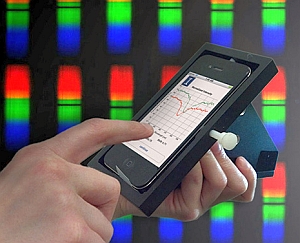Engineers at University of Illinois in Urbana created a system harnessing an iPhone’s camera to turn the phone into a biosensor that can detect proteins, bacteria, viruses, and toxins. The team led by engineering professor and entrepreneur Brian Cunningham published its findings in a recent online issue of the journal Lab on a Chip (paid subscription required).
The biosensor is based on the ability of photonic crystals to alter the frequency of light, which are then captured by the smartphone’s camera. The materials in a photonic crystal block certain wavelengths, creating a gap in the wave bands. These crystals, and their corresponding band gaps, can be structured to control light energy in predictable ways, analogous to integrated circuits controlling the flow of electrons.
In the case of the Illinois sensor, biological material — e.g., proteins or bacteria — binds to the photonic crystal, altering the reflected light frequency from a shorter to longer wave length, and changing color accordingly. The system built by Cunningham’s team has a wedge-shaped cradle that holds the iPhone, as well as a microscope slide with the specimen sample. The slide is coated with photo-sensitive primer configured to react to a specific biological target.
The technician inserts the slide with the specimen sample into the cradle and the reflected light spectrum is measured. The cradle also contains optical components aligned with the phone’s camera, which captures and transfers the image to the phone’s processor where software measures the spectrum and analyzes the data. The processing first identifies the spectrum gap, then remeasures the shift in reflection to calculate the amount of the target molecule in the test specimen.
In the journal article, Cunningham and colleagues demonstrated detection of an antibody protein, but they say the specimen slide can be primed to test for any biological molecule or cell type. The researchers note their handheld system with components costing about $200 performs the same functions as a laboratory spectrophotometer costing $50,000.
The software app prepared for the system can analyze a sample in a few minutes. The researchers are developing manufacturing processes for the iPhone cradle, as well as a version of the entire system for Android devices. Cunningham’s lab received a National Science Foundation grant earlier this year to expand the biomaterials the device can detect to include mRNA sequences for identifying a bacterial pathogen, HIV viral antibodies, and toxic chemicals that contaminate harvested corn.
In 2000, Cunningham co-founded SRU Biosystems, located in Woburn, Massachusetts. The company develops optical-based sensors of biological molecules, and Cunningham continues as the company’s chief technologist.
In the following video, Cunningham and two graduate sudents demonstrate the smartphone biosensor.
- Antibiotic Resistance Biosensor Developed for Staph Bacteria
- Portable White Blood Cell Measurement Device Developed
- Gold Nanoparticle Biosensor Developed for Simple Diagnostics
- Blood Test Technology Devised with Lab Chip, Smartphone App
- Nanotech Sensor Detects Glucose for Diabetes Testing
* * *


 RSS - Posts
RSS - Posts
You must be logged in to post a comment.